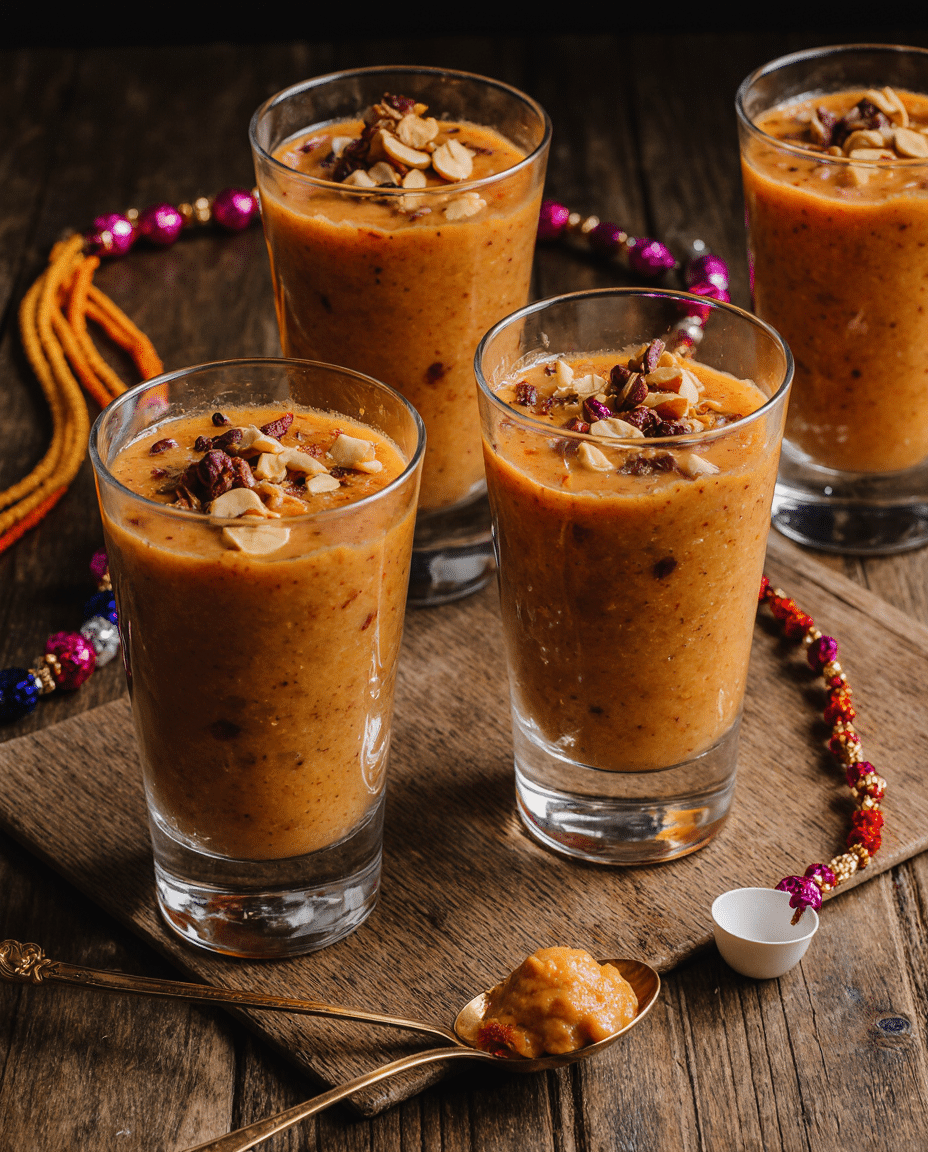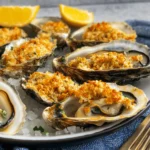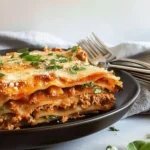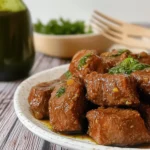Gajar Halwa Cups are an elegant, festive twist on the traditional Indian carrot halwa, making them perfect for Rakhi celebrations. By serving the rich, slow-cooked halwa in delicate, edible or paper dessert cups, you get all the comforting flavors of the classic sweet caramelized carrots, ghee, cardamom, and condensed milk but with a modern, party-friendly presentation.
FULL RECIPE
Ingredients
- 4 cups grated carrots (preferably red or juicy orange carrots)
- 2 tablespoons ghee
- 1½ cups full-fat milk
- ½ cup sweetened condensed milk
- 2 tablespoons sugar (adjust to taste)
- ½ teaspoon cardamom powder
- 2 tablespoons chopped cashews
- 2 tablespoons chopped almonds
- 1 tablespoon golden raisins
- 1 tablespoon pistachios (for garnish)
- Edible dessert cups or mini tart shells (about 6–8)
Directions
- Heat ghee in a non-stick pan over medium heat. Add chopped cashews, almonds, and raisins. Sauté until golden, then remove and set aside.
- Add grated carrots to the same pan and sauté in ghee for 5–7 minutes until they soften and start to release their aroma.
- Pour in the milk, stir, and cook uncovered on medium heat for 10–12 minutes, stirring occasionally, until the carrots are tender and the milk reduces.
- Add the condensed milk and sugar, then mix well. Continue cooking, stirring frequently, until the mixture thickens and the liquid evaporates (about 10 more minutes).
- Stir in the cardamom powder and sautéed dry fruits. Cook for an additional 2–3 minutes until the halwa becomes glossy and ghee starts to separate.
- Cool the mixture slightly, then spoon it into edible dessert cups or mini tart shells.
- Garnish with chopped pistachios and a sprinkle of edible silver leaf (optional).
- Serve warm or at room temperature during your Rakhi celebrations.
Nutrition Facts
- Calories: 210 kcal
- Total Fat: 9g
- Saturated Fat: 4g
- Cholesterol: 15mg
- Sodium: 50mg
- Total Carbohydrates: 30g
- Dietary Fiber: 2g
- Sugars: 20g
- Protein: 4g
- Calcium: 80mg
- Iron: 0.8mg
- Potassium: 250mg
A Festive Spin on a Traditional Classic
Gajar Halwa Cups transform a beloved Indian dessert into a visually appealing, portion-controlled treat that’s ideal for festive gatherings like Raksha Bandhan. Traditionally served warm in bowls, gajar halwa gets a modern makeover when served in decorative cups or edible shells. This twist doesn’t just make the sweet easier to serve—it enhances presentation while keeping the nostalgic flavors intact. Guests can enjoy the richness of the halwa without the need for plating or sharing, making it perfect for elegant parties or intimate family functions.
Nutritional Benefits of Carrots
Carrots are the heart of this dessert, offering a naturally sweet base that’s loaded with health benefits. Rich in beta-carotene (which converts to vitamin A), carrots support eye health, skin renewal, and immune function. They’re also high in fiber, low in fat, and offer essential vitamins like K1, B6, and potassium. While this is still a dessert, the presence of carrots adds a layer of wholesomeness, making each bite not just indulgent but also nutritionally valuable, especially when balanced with moderate sweetness and healthy fats.
Role of Ghee and Its Ayurvedic Importance
Ghee is a cornerstone of Indian cooking and holds particular significance in festive sweets like gajar halwa. It adds a rich, nutty flavor and contributes to the dessert’s luxurious mouthfeel. In Ayurveda, ghee is believed to aid digestion, improve nutrient absorption, and enhance memory and immunity. While it’s calorie-dense, using ghee in moderation offers both flavor and potential wellness benefits. In gajar halwa, it helps bind the ingredients and adds depth, creating a sensory experience that’s both comforting and satisfying.
Why Serving in Cups Makes Sense
Serving gajar halwa in individual cups has both practical and aesthetic benefits. For one, it ensures cleaner presentation and easier portion control, especially for large gatherings or events where multiple dishes are served buffet-style. It also adds an element of charm—beautifully layered halwa in glass or edible tart shells can elevate your dessert table. Cups can also accommodate customizations, such as individual garnishes or flavor infusions, making each serving feel personal and special.
Creative Variations for Diverse Palates
Gajar Halwa Cups can be customized endlessly to suit different dietary needs and preferences. For a richer flavor, substitute part of the milk with evaporated milk or coconut milk. Vegans can use almond milk and plant-based condensed milk alternatives, along with coconut oil instead of ghee. To add texture, try mixing in grated khoya or a sprinkle of desiccated coconut. Those who prefer more complexity can flavor the halwa with a pinch of saffron or rose water. You can even create fusion versions by layering with rabri or chocolate ganache for a contemporary twist.
Ideal Pairings for a Festive Spread
When planning a Rakhi or festive menu, pairing is key to enhancing the overall dining experience. Gajar Halwa Cups go beautifully with beverages like masala chai, cardamom-infused milk, or rose lassi. They also pair well with savory snacks like samosas, paneer tikka, or stuffed parathas to balance the sweetness with spice and richness. For a grander spread, include other mini desserts like rasmalai shots or peda truffles to offer a contrast in textures and flavors.
Make-Ahead and Storage Tips
Gajar Halwa Cups are very make-ahead friendly, which is ideal for busy festive preparations. You can cook the halwa a day or two in advance and refrigerate it in an airtight container. Just before serving, reheat it gently on the stovetop or in the microwave until warm, then spoon into cups. If using edible tart shells, fill them just before serving to avoid sogginess. The halwa itself can be stored in the refrigerator for up to 4–5 days and even frozen for a month, although fresh is always best for texture and flavor.
Garnishing for Visual Appeal and Flavor
The garnish isn’t just decorative—it plays a functional role in enhancing both flavor and texture. Chopped pistachios add a vibrant green pop and a delicate crunch. Edible silver leaf (varak) brings traditional flair and festive shimmer, while dried rose petals offer fragrance and visual sophistication. You can also top each cup with a small dollop of malai or a swirl of whipped cream for a modern, creamy contrast. Even something as simple as a single cashew or almond can make each serving feel luxurious and intentional.
Kid-Friendly and Crowd-Pleasing
Because of their size and mild sweetness, Gajar Halwa Cups are very kid-friendly. The soft, pudding-like texture and subtle spices appeal to younger palates, and their colorful appearance makes them fun and enticing. For children who may not be fans of nuts or cardamom, you can adjust the recipe by reducing spice and using fewer mix-ins. These mini cups also make portion control easier for parents and give everyone a chance to try other items from a dessert spread without overindulging.
Advertisement
Balancing Indulgence with Health
While gajar halwa is traditionally a rich dessert, serving it in cups helps balance indulgence with mindfulness. Instead of consuming a full bowl of halwa, guests enjoy a measured serving that satisfies without overwhelming. You can also tweak the recipe by using less sugar or substituting with natural sweeteners like dates or jaggery. Using low-fat milk or skipping condensed milk can lighten the dessert without drastically changing the flavor. These minor adjustments allow for guilt-free enjoyment during festive occasions.
Conclusion
Gajar Halwa Cups beautifully blend the nostalgia of traditional Indian sweets with the elegance of modern presentation. Perfect for Rakhi and other festive occasions, they bring together nutrition, flavor, and visual appeal in a way that feels both celebratory and mindful. Their versatility, make-ahead convenience, and ability to please both adults and children alike make them a standout dessert for any occasion.






